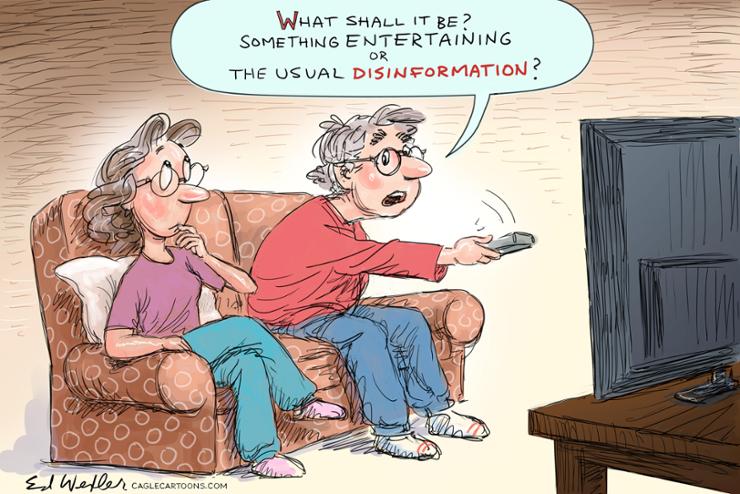The Usual Disinformation: Navigating the Murky Waters of Fake News in the Digital Age
The proliferation of disinformation, often fueled by political agendas, economic incentives, or simply malicious intent, has become a pervasive challenge in the digital age. No longer confined to whispers and rumors, false narratives now spread rapidly and widely through social media platforms, online news outlets, and even seemingly reputable sources, eroding public trust and potentially destabilizing societies. Understanding the mechanics of disinformation, its various forms, and the motivations behind it is crucial to navigating the increasingly complex information landscape and safeguarding against its insidious effects. From manipulated videos and fabricated news stories to carefully crafted propaganda and coordinated disinformation campaigns, the tactics employed are ever-evolving, demanding constant vigilance and critical evaluation from consumers of information.
One of the key characteristics of modern disinformation campaigns is their ability to exploit the very structure and algorithms of social media platforms. These platforms, designed to maximize engagement and virality, often inadvertently amplify misleading or outright false content. The algorithms prioritize content that evokes strong emotions, regardless of its veracity, creating a fertile ground for sensationalized headlines and emotionally charged narratives to gain traction. This is further exacerbated by the echo chamber effect, where users are primarily exposed to information that confirms their pre-existing biases, reinforcing beliefs and making them less receptive to contradictory evidence. The speed at which information travels online also contributes to the problem, making it difficult for fact-checking organizations to debunk false claims before they reach a wide audience. Moreover, the anonymity afforded by the internet allows malicious actors to spread disinformation without accountability, further complicating efforts to identify and address the sources of these campaigns.
The motivations behind disinformation campaigns are diverse and often intertwined. Political actors may utilize disinformation to manipulate public opinion, discredit opponents, or interfere in elections. Economic incentives can drive the creation and dissemination of fake news for profit, as sensationalized content attracts clicks and generates advertising revenue. In some cases, disinformation campaigns are orchestrated by foreign governments seeking to sow discord and undermine democratic institutions in other countries. The rise of sophisticated technologies like deepfakes, which can create realistic but fabricated videos, has added another layer of complexity to the disinformation landscape, making it increasingly difficult to distinguish between authentic and manipulated content. This blurred line between reality and fabrication poses a significant threat to public trust and the integrity of information.
Combating the spread of disinformation requires a multi-faceted approach involving individuals, platforms, and governments. Media literacy education is crucial in empowering individuals to critically evaluate information and identify potential signs of manipulation. This includes developing skills in source verification, fact-checking, and understanding the difference between news reporting and opinion pieces. Social media platforms must also take greater responsibility for the content hosted on their sites, implementing stricter policies and investing in technologies to detect and remove disinformation campaigns. Fact-checking organizations play a vital role in debunking false claims and providing accurate information, but their resources are often stretched thin in the face of the overwhelming volume of disinformation circulating online. International cooperation is also essential to address the transnational nature of many disinformation campaigns, sharing best practices and coordinating efforts to combat this global challenge.
Government regulation of online content remains a contentious issue, with concerns about potential censorship and restrictions on freedom of speech. However, some argue that stricter regulations are necessary to curb the spread of harmful disinformation, particularly when it poses a threat to public health or national security. Finding the right balance between protecting free speech and safeguarding against the harmful effects of disinformation is a complex challenge that requires careful consideration. Transparency in online advertising and the funding of online platforms is also crucial to understanding the financial incentives driving the creation and dissemination of disinformation. Greater transparency can help expose hidden agendas and hold those responsible for spreading disinformation accountable.
Ultimately, the fight against disinformation is a continuous and evolving battle. As technology advances and the tactics of disinformation campaigns become more sophisticated, individuals, platforms, and governments must adapt and strengthen their efforts to counter this growing threat. Fostering a culture of critical thinking, media literacy, and responsible online behavior is essential to building resilience against disinformation and ensuring that accurate and reliable information remains accessible in the digital age. The future of informed decision-making, public trust, and democratic discourse depends on our collective ability to navigate the murky waters of disinformation and uphold the value of truth.


